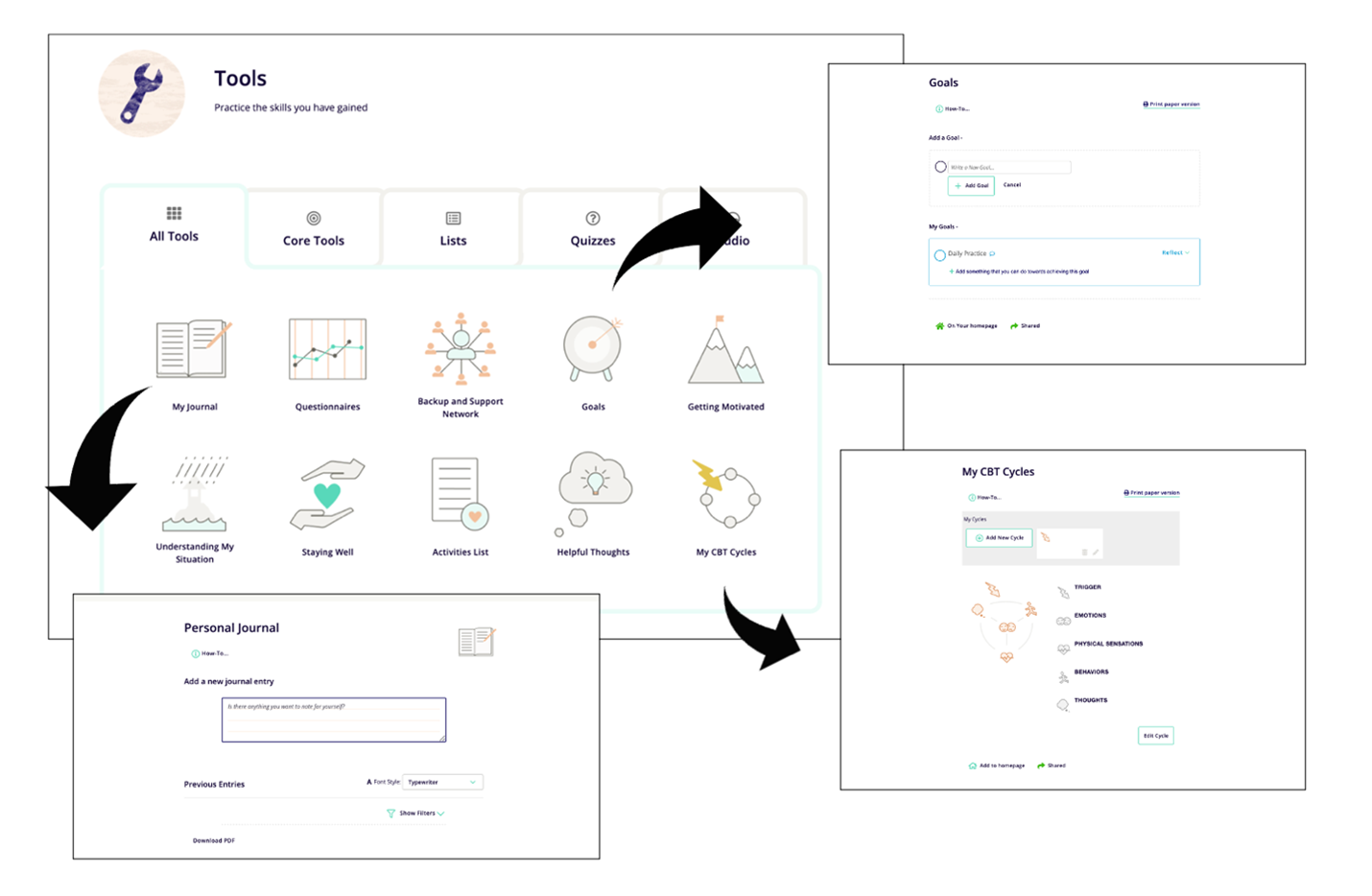 Nowadays, most people use many online services. We buy clothes, do our grocery shopping, manage our money via online banking, and socialise through apps. We also educate and improve ourselves by taking online courses or workshops. However, is therapy something that you can receive like one of those digital services? Is it possible to receive an evidence-based therapy like CBT digitally? Can you benefit from digital CBT in dealing with your psychological problems? The answer to all these questions is Yes.
Nowadays, most people use many online services. We buy clothes, do our grocery shopping, manage our money via online banking, and socialise through apps. We also educate and improve ourselves by taking online courses or workshops. However, is therapy something that you can receive like one of those digital services? Is it possible to receive an evidence-based therapy like CBT digitally? Can you benefit from digital CBT in dealing with your psychological problems? The answer to all these questions is Yes.
It is very understandable and important that you ask these questions. Mental health care is a sensitive topic and requires careful consideration and understanding of what works for you. As a clinical psychologist, who received years of clinical training to provide face-to-face therapy, I had my own doubts about digital therapies that do not involve face-to-face interaction with a psychotherapist. When I did some research, I was surprised to find out that digital CBT provided with human guidance and face-to-face CBT resulted in equivalent overall effects for psychiatric and somatic disorders1,2.
When I dug deeper, I found out that there has been an accumulation of scientific evidence from clinical trials since the 2000s that has consistently demonstrated the efficacy and effectiveness of digital CBT programmes. Research has proven its benefits for a broad range of psychological conditions and comorbidity of psychological conditions and physical diseases. These conditions include depression and anxiety disorders, stress, body dysmorphic disorder, pathological gambling, procrastination, interpersonal violence, perfectionism, loneliness, cancer, cardiac problems, insomnia, chronic pain, tinnitus, headache, erectile dysfunction, hearing loss, and irritable bowel syndrome3.
What is digital CBT?
Many people are familiar with CBT delivered by a therapist through videoconferencing using applications such as Skype and Zoom. However, in this instance, digital CBT refers to self-help CBT-based programmes delivered via the internet. The primary aim of digital CBT programmes is to increase access to evidence-based psychological therapies to enhance mental health and well-being at a community-wide level.
Digital CBT programmes aim to communicate the key principles of CBT with examples, videos, and interactive exercises. They are typically simple and brief. Their focus is on the use of CBT materials and techniques and emphasising the value of between-session exercises. They regularly assess, monitor, and evaluate patients’ progress.

Digital CBT programmes involve strategies that fall under the CBT umbrella such as goal setting, behavioural activation, identifying dysfunctional thinking patterns, cognitive reframing, mood monitoring, and mindfulness exercises. Like face-to-face CBT, they aim to help you understand your problems, apply the CBT model to yourself, and equip yourself with tools that can help you. SilverCloud programmes are examples of this.
Digital CBT programmes can be entirely self-guided which involves practising self-administrative exercises and techniques without any external support. They can also be guided which involves the same self-administrative exercises and techniques, however, a clinician or a trained supporter also provides feedback and encouragement at regular planned intervals. Digital CBT is often delivered as a standalone treatment; however, it can also be used as an adjunct to face-to-face therapy to reduce waiting times and improve clinical efficiency4.
What makes CBT work well digitally?
Cognitive Behavioural Therapy (CBT) is a brief, time-limited, highly structured, and problem-oriented therapy model. It requires the individual to understand the nature of their condition and learn new skills to better manage their mood. Given the proactive role the patient needs to take in this journey, CBT works well in an online modality.
The approach and techniques used in digital CBT programmes and face-to-face CBT are quite similar. Both focus on providing psychoeducation to clients about their problems with the help of the CBT model and helping them achieve cognitive and behavioural change. The goal of both is to help clients develop effective coping strategies and learn when and how to use these to help themselves when they encounter similar problems in life.
As a highly structured therapeutic approach, CBT makes it possible to digitally present the same techniques a therapist would use in face-to-face CBT. In face-to-face therapy, these tools are applied with the help of a therapist using paper and pen. In digital therapy, the same tools are demonstrated via a digital platform through interactive exercises, videos, and examples.
Is digital CBT for me?
An extensive body of research shows that digital CBT for anxiety and depression disorders is effective, acceptable, and practical (5). Clients who used digital CBT programmes felt a greater sense of self-efficacy, empowerment, and achievement at the end of the programme6,7. You may as well benefit from understanding your condition and practising tools without requiring help from a therapist. However, there are important things to consider before deciding whether digital CBT is for you.
1. Severity of the psychological condition
One important thing to consider is that digital CBT interventions usually entail minimal therapist contact. They have been mainly developed for individuals with mild-to-moderate psychological conditions, although recent evidence shows individuals with more severe presentations can also benefit from them. Guidelines such as the National Institute for Health and Care Excellence (NICE) in the UK recommend face-to-face CBT for severe mental and emotional health issues8,9,10. If you are experiencing serious impairment in your daily functioning within your social and/or occupational life because of your psychological condition, it is important to discuss with your doctor or mental health professional, what is the best approach for you.
2. Strong preference for face-to-face therapy
One of the main differences between digital CBT and face-to-face CBT is the amount of therapist contact (11). In digital CBT, there is less or no contact with a therapist. On the other hand, face-to-face CBT requires a regular and longer duration of contact with a therapist. If you prefer having more intensive care and in-person contact with a therapist, then digital CBT as a main treatment option may not meet your expectations.
3. Anonymity and privacy
One of the most common reasons for people to avoid seeking therapy is the fear of stigma. If you need professional help but are not seeking it due to fear of being stigmatised by others, digital CBT can be a very good alternative for you. An advantage of digital CBT over face-to-face CBT is that it offers anonymity. Since it does not require you to go to a therapist’s office, it offers more privacy compared to in-person treatment.
4. Flexibility
If you have a busy life that prevents you from committing to a weekly therapy session in a therapist’s office, digital CBT can be a great alternative. Digital CBT programmes offer flexibility as you can access them wherever, whenever 24/7. You can work on the modules during your commute, at lunch time, or while you sit in the car waiting for your kids to finish school. You can fit it around your busy life and it allows you to work on it at your own pace.
Conclusion
Digital CBT has become an alternative evidence-based approach that primary healthcare settings offer worldwide as it offers easy and speedy access to treatment. Like face-to-face CBT, digital CBT encourages individuals to take an active role and gain skills to become their own therapist but with a low-intensity intervention. Extensive research has proven that guided digital CBT has equivalent effects to face-to-face CBT.
If you think that digital CBT may work for you, contact your local healthcare provider, health insurer, GP or Primary Care doctor, or if you are a student, your university.
References
1. Moshe I, Terhorst Y, Philippi P, Domhardt M, Cuijpers P, Cristea I, et al. Digital Interventions for the Treatment of Depression: A Meta-Analytic Review. Psychol Bull. 2021;147(8):749–86.
2. Carlbring P, Andersson G, Cuijpers P, Riper H, Hedman-Lagerlöf E. Internet-based vs. face-to-face cognitive behavior therapy for psychiatric and somatic disorders: an updated systematic review and meta-analysis. Cogn Behav Ther [Internet]. 2018;47(1):1–18. Available from: http://doi.org/10.1080/16506073.2017.1401115
3. Andersson G. Internet interventions : Past , present and future. Internet Interv. 2018;(12):181–8.
4. Duffy D, Enrique A, Connell S, Connolly C, Richards D. Internet-Delivered Cognitive Behavior Therapy as a Prequel to Face-To-Face Therapy for Depression and Anxiety: A Naturalistic Observation. Front Psychiatry. 2020 Jan 9;10.
5. Andrews G, Cuijpers P, Craske MG, McEvoy P, Titov N. Computer therapy for the anxiety and depressive disorders is effective, acceptable and practical health care: A meta-analysis. PLoS One. 2010;5(10).
6. Richards D, Dowling M, O’Brien E, Viganò N, Timulak L. Significant events in an Internet-delivered (Space from Depression) intervention for depression. Couns Psychother Res. 2018;18(1):35–48.
7. Burke J, Richards D, Timulak L. Helpful and Hindering events in internet-delivered cognitive behavioural treatment for generalized anxiety. Behavioural and Cognitive Psychotherapy. 2018;47(3):386–99.
8. National Institure for Health and Clinical Excellence. Evidence standards framework for digital health technologies [Internet]. 2018. Available from: www.nice.org.uk/corporate/ecd7
9. National Institute for Health and Care Excellence. Depression in adults: recognition and management Clinical guideline [Internet]. 2009. Available from: www.nice.org.uk/guidance/cg90
10. National Institute for Health and Clinical Excellence (NICE). Generalised anxiety disorder and panic disorder in adults: management [Internet]. 2011. Available from: www.nice.org.uk/guidance/cg113
11. Bennett-Levy J, Richards D, Farrand P. Low intensity CBT interventions: A revolution in mental health care. In: Bennett-Levy J, Richards D, Farrand P, Christensen H, Griffiths K, Kavanagh D, et al., editors. Oxford Guide to Low Intensity CBT Interventions [Internet]. Oxford: Oxford University Press; 2010. p. 3–18. Available from: http://www.oxfordclinicalpsych.com/view/10.1093/med:psych/9780199590117.001.0001/med-9780199590117-chapter-1







